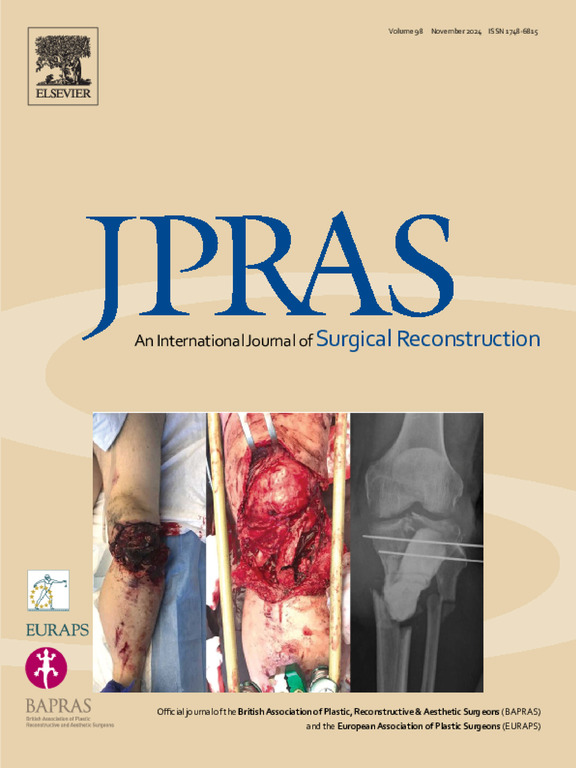Retro-orbicularis oculi fat reduction via sub-brow incision in thyroid eye disease
IF 2.4
3区 医学
Q2 SURGERY
Journal of Plastic Reconstructive and Aesthetic Surgery
Pub Date : 2025-09-08
DOI:10.1016/j.bjps.2025.09.006
引用次数: 0
Abstract
The retro-orbicularis oculi fat (ROOF) hypertrophy contributes to upper eyelid fullness in patients with thyroid eye disease (TED). This report describes the surgical technique and evaluates the aesthetic and clinical outcomes of ROOF reduction via a sub-brow incision in patients with TED. This retrospective observational study included 60 patients (118 eyelids; 2 males and 58 females; mean age, 46.2 ± 13.2 years) who underwent ROOF excision between October 2019 and January 2025. Data collected included patient demographics, surgical details, ROOF thickness (measured by imaging studies), volume of excised fat, margin reflex distance-1 (MRD-1), and postoperative complications. Patient satisfaction was assessed at the 3-month follow-up. Consequently, the mean volume of ROOF excised was 0.69 ± 0.51 mL. Concurrent fat removal included excision of the preaponeurotic fat pad in 77 eyelids (mean volume excised: 0.59 ± 0.23 mL) and the medial fat pad in 45 eyelids (mean volume excised: 0.17 ± 0.10 mL). ROOF thickness correlated moderately with the volume excised (r = 0.395, p < 0.001). MRD-1 did not significantly change postoperatively (preoperative: 4.4 ± 1.1 mm; postoperative: 4.5 ± 1.0 mm; p = 0.626). A high patient satisfaction rate of 93.3% was achieved. No major complications were reported. This report indicates that ROOF excision via a sub-brow incision is a safe and effective adjunct to aesthetic eyelid surgery, offering improved cosmetic outcomes with a low complication rate. This technique may be considered in patients with TED presenting with prominent upper eyelid fullness.
经眉下切口减脂治疗甲状腺眼病的眼轮匝肌后。
眼轮匝肌后脂肪(ROOF)肥大有助于甲状腺眼病(TED)患者的上眼睑丰满。本报告描述了手术技术,并评估了通过眉下切口在TED患者中进行ROOF复位的美学和临床结果。这项回顾性观察性研究包括60例患者(118眼睑,2男58女,平均年龄46.2±13.2岁),他们在2019年10月至2025年1月期间接受了ROOF切除术。收集的数据包括患者人口统计学、手术细节、ROOF厚度(通过影像学研究测量)、切除脂肪体积、边缘反射距离-1 (MRD-1)和术后并发症。在3个月的随访中评估患者满意度。因此,切除ROOF的平均体积为0.69±0.51 mL。同时切除脂肪包括切除77个眼睑的腱膜前脂肪垫(平均体积:0.59±0.23 mL)和45个眼睑的内侧脂肪垫(平均体积:0.17±0.10 mL)。顶板厚度与切除体积呈正相关(r = 0.395, p < 0.001)。MRD-1术后无明显变化(术前:4.4±1.1 mm;术后:4.5±1.0 mm; p = 0.626)。患者满意率达93.3%。无重大并发症报道。本报告表明,通过眉下切口进行ROOF切除是一种安全有效的辅助眼睑美容手术,可改善美容效果,并发症发生率低。这种技术可以考虑在TED患者表现为突出的上眼睑丰满。
本文章由计算机程序翻译,如有差异,请以英文原文为准。
求助全文
约1分钟内获得全文
求助全文
来源期刊
CiteScore
3.10
自引率
11.10%
发文量
578
审稿时长
3.5 months
期刊介绍:
JPRAS An International Journal of Surgical Reconstruction is one of the world''s leading international journals, covering all the reconstructive and aesthetic aspects of plastic surgery.
The journal presents the latest surgical procedures with audit and outcome studies of new and established techniques in plastic surgery including: cleft lip and palate and other heads and neck surgery, hand surgery, lower limb trauma, burns, skin cancer, breast surgery and aesthetic surgery.

 求助内容:
求助内容: 应助结果提醒方式:
应助结果提醒方式:


